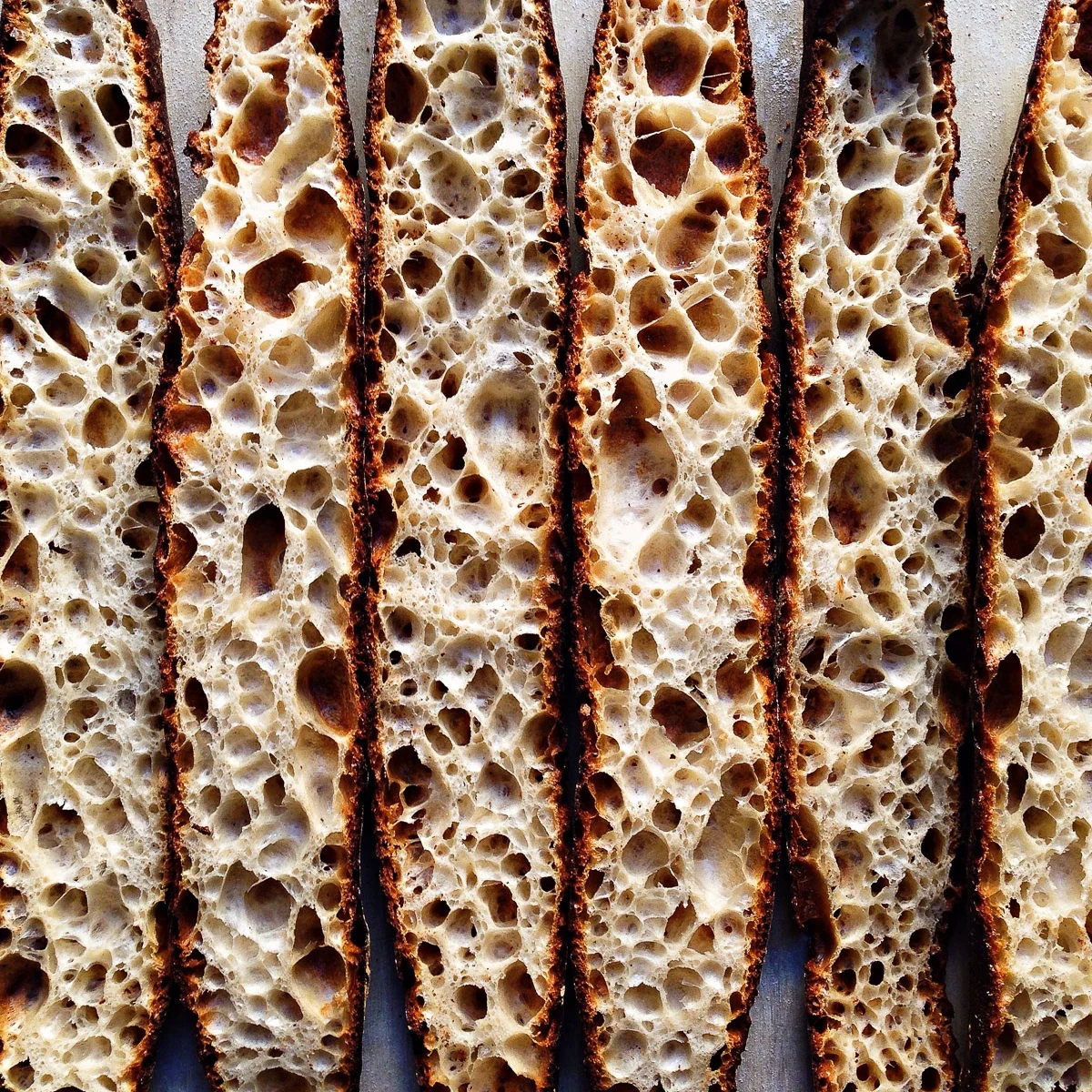Bread FAQ Part 1: How to Get an Open Crumb
I get asked a lot of questions about bread so I thought I would put together a FAQ section to help people out with the most common questions I'm asked. While I could probably write pages and pages about any of these topics the articles here will be more of an overview intended to get people headed in the right direction rather than super in depth technical manuals. However, I might decide to go into more depth on certain subjects if there is enough interest so check back often!
How do you get an "open" crumb?
This is by far the most common question I'm asked but it's not really all that easy to answer. This is mainly due to how much is involved in achieving it. Every step in the process is important: you need a healthy starter, good flour, proper equipment, good timing, gentle shaping ect. Fail at any of these parts and you won't have success. Honestly, there is so much involved I would probably need to write a book to cover it all. I do, however, want to touch on one concept that I don't think gets a lot of attention and could be one of the most important factors in achieving an open crumb: strong, extensible dough.
STRONG, EXTENSIBLE DOUGH EXPLAINED
So what is a strong and extensible dough? Let's start with the strong part. A strong dough, in my mind, is one that has a well developed network of gluten that can trap the CO2 that the yeasts give off. Think of a balloon blowing up. We want our dough to act like a balloon catching all the breaths from the yeast. The stronger the gluten network the more CO2 the dough can hold. This will effectively give our bread more volume in the end than a bread with a weaker gluten network. So if you want an open crumb with as much airiness you can get your first goal is to make your dough as strong as possible. Ways to get your dough stronger: Use stronger flour, mix longer, do more folds during bulk fermentation, stretch your folds a little more during bulk etc.
There is one problem with all this strength, however. If all you do is make your dough as strong as possible you will run into a serious issue. First, your dough will be so elastic that it won't be able to rise against it's own strength. Think of trying to blow up a car tire with just your breath. Sure the rubber is extremely strong and could hold loads of air before it pops but you don't have the strength in your breath to inflate it in the first place because the rubber is so strong. The same thing happens with overly elastic dough. The yeast don't have enough strength to inflate it. What we need is a dough that is very strong but also relatively easy to blow up. This is where extensibility comes in.
One of my favorite bread books, Michel Sua's Advanced Bread and Pastry, defines extensibility as "the property of the dough to elongate easily". In other words, you are able to stretch the dough without too much resistance which is exactly what we need to solve the issue with having strong dough. There are two main tools I like to use to make a dough more extensible: Autolyse and high hydration. First let's talk about autolyse.
An autolyse is a technique in which the baker mixes the flour and water for a dough together, holding back salt and any leavening(ie. starter or yeast). I won't go into the technical details here(see Advanced Bread and Pastry for a detailed explanation of the autolyse) but the result of this technique is a more extensible dough. In general, the longer you autolyse the more extensible your dough will be. Bakers will use anything from a quick 15 minute autolyse to an extended overnight autolyse where the dough is kept in cold storage to get the results they want.
The other option to gain extensibility in your dough is to use a lot of water in your mix. I think that most bakers have experienced the effects of mixing a stiff dough vs. a very wet one. The stiff dough is usually very elastic while the wet dough has a slack feel. That wet dough feel is a form of extensibility. Pull on a wet dough and you probably won't have much resistance. The wetter you make your dough, the more extensible it will become.
KEEPING IT IN BALANCE
So how do we use all this information to get a great crumb? It's all about balance. Too much strength and not enough extensibility will result in a tight loaf with a round cross section. A loaf with too much extensibility and not enough strength will have a flatter profile and lack volume. Both these examples will produce less than ideal crumbs. The key to getting a loaf with a ton of volume and a light airy crumb is finding the balance between these properties. If you really want to push the limits of what's possible in a crumb I would suggest maximizing your dough's strength and then using a combination of autolyse and hydration to create a dough that remains extensible despite being very strong. In other words: don't be afraid to make your dough super strong as long as you have the extensibility to keep all that strength in check.
I've left out a lot of specifics for the sake of brevity so if you have any further questions feel free to ask below! And if you're completely lost, check out my beginning bread lessons site abreaducation.com or my list of recommended bread books for more help than I could ever provide. Happy baking!




